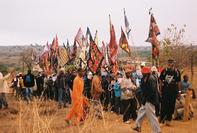Tribal Authorities
As white colonists imposed their rule on Tsonga villages, the powers of chiefs declined. By the 1920s many whites saw in the disintegration of the chiefdom the spectre of political lawlessness.

Segregationists saw the 'tribe' as the 'natural' home of an African population entering into increasing competition with whites in urban areas. The position of the chief was strengthened by legislation in the 1920s and, 30 years later, 'tribal authorities' became crucial to the Bantustan system. Traditionally the chief 'hosi' and his council have the final authority and still form an important part of government in all Tsonga groups.
Chieftainship is hereditary and falls to the most senior member of the oldest lineage in the strongest clan in the group. The new chief must be approved by the council and formally inducted into office. Should he be a minor on the death of his father, his father's younger brother normally acts as regent. In the past the hosi wielded supreme power.
He allocated land and sanctioned the start of initiation rites, harvest ceremonies and rain dances; he mediated between members of the group and ancestral spirits; he made all decisions relating to war and the army; he was also responsible for the administration of the group, and tried serious cases and those on appeal from headmen. He was assisted by officials who carried out special tasks. Today chiefs are paid civil servants responsible for administering the people under their charge.
They have to collect taxes and oversee such services as the allocation of piped water or the construction of new classrooms. They continue to play an important role as centres of loyalty, identity and affection for rural communities